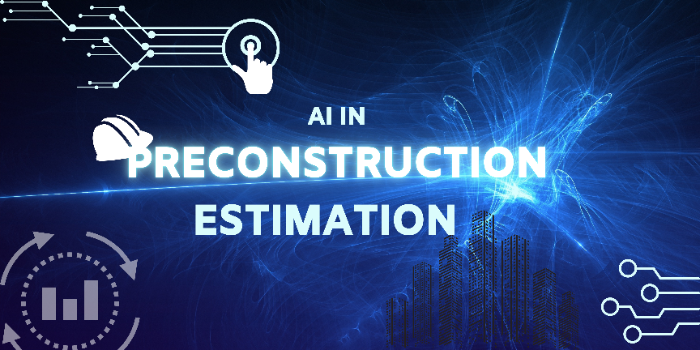
AI in Preconstruction Estimation: Streamlining Feasibility Studies and Budget Forecasts
The construction industry is notorious for its complex planning stages, particularly when it comes to preconstruction estimation. Accurate feasibility studies and budget forecasts are essential to the success of any project. These early-stage tasks can make or break a project long before the ground is broken. In recent years, Artificial Intelligence (AI) has begun to play a pivotal role in transforming how construction firms approach preconstruction estimation. By leveraging AI-driven tools, companies are now able to streamline their processes, make data-driven decisions, and produce more accurate results.
In this article, we will explore how AI is revolutionizing pre-construction estimation, focusing on its role in feasibility studies and budget forecasting. We'll also examine real-world case studies that showcase how AI can improve project planning and lead to more successful construction projects.
The Importance of Preconstruction Estimation
Before delving into how AI is transforming the landscape, it's essential to understand why pre-construction estimation is such a critical part of the construction process. At this stage, project stakeholders need accurate information to make informed decisions about the feasibility, cost, and timelines of a project.

Feasibility Studies: These are conducted to determine whether a proposed project is viable from a technical, financial, and operational perspective. A poor feasibility study can result in wasted resources, time, and even project failure.
Budget Forecasting: Accurate budget forecasts are essential to avoid cost overruns, which are common in construction projects. Overruns can cause delays, compromise the quality of work, and lead to disputes among stakeholders.
Historically, these tasks have been time-consuming and prone to human error. Estimators must sift through large amounts of data, evaluate potential risks, and make assumptions that can be costly if incorrect. AI changes the game by automating many of these tasks and offering more precise insights based on vast datasets.
How AI is Revolutionizing Preconstruction Estimation
1. AI-Driven Feasibility Studies
AI tools can process and analyze vast amounts of data, providing actionable insights that improve the accuracy of feasibility studies. Traditionally, feasibility studies involve a lot of guesswork and are based on historical data, expert judgment, and assumptions. AI removes much of the guesswork by utilizing data analytics, pattern recognition, and predictive modeling.
.png)
Data Analysis: AI algorithms can process large datasets, including information on material costs, labor rates, environmental factors, and previous project outcomes. This level of analysis allows estimators to get a more comprehensive view of the potential challenges and risks associated with a project.
Pattern Recognition: AI tools can identify patterns in historical project data to predict future outcomes. For example, if a specific type of project in a particular geographic region has consistently faced delays due to weather, AI can flag this as a potential risk.
Predictive Modeling: AI-driven predictive models can simulate various project scenarios, helping estimators and project managers understand the potential impact of different variables. This enables a more informed decision-making process early in the project planning stage.
2. AI in Budget Forecasting
Budget forecasting is another critical area where AI is making a significant impact. Accurate cost estimation is often a challenge, especially for large-scale construction projects. AI offers a more efficient and accurate way to forecast budgets by analyzing data from multiple sources.
Cost Prediction Models: AI algorithms can predict costs with a higher level of accuracy by considering various factors like material costs, labor rates, inflation, and market trends. Traditional methods often rely on outdated information, whereas AI can provide real-time data analysis.
Risk Management: One of the biggest challenges in budget forecasting is accounting for uncertainties and risks. AI can help identify potential risks (e.g., market fluctuations, and supply chain disruptions) and suggest strategies for mitigating them. This proactive approach allows companies to allocate resources more effectively and avoid costly surprises down the line.
Resource Optimization: AI tools can also analyze the allocation of resources, such as labor and materials, to optimize project schedules and minimize waste. By doing so, they contribute to cost savings and more efficient project execution.
AI-Powered Tools for Preconstruction Estimation
Several AI-powered tools are transforming the way construction companies approach preconstruction estimation. These tools leverage machine learning, natural language processing, and data analytics to enhance decision-making processes.
.png)
BidLight: This AI-driven platform automates construction estimation and project planning, helping estimators generate more accurate bids and improve project timelines. With its AI-powered algorithms, BidLight analyzes vast datasets to create cost estimates that are both precise and realistic.
Doxel: Doxel uses AI to monitor and track project progress in real-time. Its predictive algorithms help construction managers forecast costs and schedules, identifying potential issues before they escalate into costly problems.
ProEst: ProEst offers AI-powered cost estimation software that allows construction companies to create detailed and accurate cost estimates in a fraction of the time it would take using traditional methods. Its AI algorithms analyze past project data to improve the accuracy of future estimates.
Benefits of AI in Preconstruction Estimation
1. Enhanced Accuracy
AI provides a level of accuracy in estimation that human estimators can struggle to achieve. By analyzing vast datasets and identifying patterns, AI tools offer more reliable predictions, reducing the margin of error in both feasibility studies and budget forecasts.
2. Time Efficiency
Preconstruction estimation is often a time-consuming process, requiring hours or even days of manual data analysis and calculation. AI tools automate much of this process, allowing estimators to focus on more strategic tasks. The result is faster decision-making and shorter project timelines.
3. Risk Mitigation
AI can identify potential risks early in the planning process, helping construction firms take proactive measures to mitigate them. This capability is especially useful in budget forecasting, where unexpected costs can derail a project.
4. Cost Savings
By providing more accurate estimates and reducing the time spent on manual tasks, AI tools can help construction companies save on labor costs. Additionally, the ability to forecast budgets with greater precision reduces the likelihood of cost overruns, leading to further savings.
Case Studies: Real-World Examples of AI in Preconstruction Estimation
1. Project: The Grand Egyptian Museum, Giza
.webp)
The construction of the Grand Egyptian Museum, one of the largest archaeological museums in the world, presented numerous challenges in terms of budgeting and feasibility due to its massive scale and complex design. The project team faced difficulties in accurately estimating costs for the various phases of the project, particularly with fluctuating material prices and labor costs.
Challenge: Estimating costs for such a unique and large-scale project was highly complex, leading to frequent adjustments in the budget and delays in the planning stages.
Solution: The team turned to AI-based estimation tools from BidLight to streamline their cost forecasting. Using historical data from similar large-scale museum projects and factoring in market conditions, the AI system provided accurate cost predictions and risk assessments.
Outcome: The team reduced the overall estimation time by 40%, and the budget accuracy improved significantly. This allowed for better resource allocation and helped prevent costly overruns that would have otherwise delayed the museum’s opening.
2. Project: Sydney Metro, Australia

The Sydney Metro project, a multi-billion-dollar expansion of the city’s transit network, faced the challenge of balancing a tight budget with the fluctuating costs of materials and labor. The project’s scale required accurate feasibility studies to avoid cost overruns and ensure timely completion.
Challenge: The sheer size of the project, spanning 66 kilometers and including numerous stations and tunnels, made it difficult to produce a reliable budget forecast using traditional methods.
Solution: The project team integrated AI-powered tools from Doxel to perform real-time monitoring of costs and materials. The system used predictive algorithms to provide accurate budget forecasts and feasibility assessments based on historical data and real-time cost inputs.
Outcome: The AI-driven feasibility study was completed 30% faster than initially expected, and the budget forecasts were 20% more accurate, helping the team avoid significant cost overruns. The real-time monitoring also allowed the team to make quick adjustments to their resource allocation, ensuring the project remained on schedule.
3. Project: Apple Park, Cupertino, California

Apple Park, the futuristic headquarters of Apple Inc., faced unique challenges in terms of design complexity and sustainability requirements. As the project evolved, ensuring that budget forecasts remained aligned with the ambitious design and construction goals was a top priority.
Challenge: The complexity of the circular, environmentally sustainable building led to significant budget overruns in the early stages of construction. The team needed a more accurate way to forecast costs and manage risks.
Solution: The construction team adopted ProEst’s AI-powered estimation software to create detailed, real-time cost forecasts. The AI algorithms analyzed previous data from similar tech company projects and factored in the unique design elements, sustainability goals, and fluctuating market conditions.
Outcome: With the implementation of AI tools, the project saw a 15% reduction in cost overruns. The software's ability to analyze vast amounts of data provided the team with an accurate, dynamic budget forecast that allowed them to manage changes efficiently while keeping the project on track.
Conclusion
AI is transforming the construction industry by improving pre-construction estimation processes, particularly in feasibility studies and budget forecasting. With AI-driven tools, construction firms can produce more accurate estimates, reduce risk, and optimize resource allocation. The result is more efficient project planning, fewer delays, and cost savings. As more companies adopt AI technology, we can expect even greater improvements in project outcomes, setting a new standard for construction estimation.
By incorporating AI into preconstruction estimation, companies are not only streamlining their processes but also paving the way for more successful and profitable projects. As these case studies have shown, the benefits of AI are real and measurable, making it an essential tool for the future of construction.
Check https://app.bidlight.com for how BidLight can help you estimate your project!